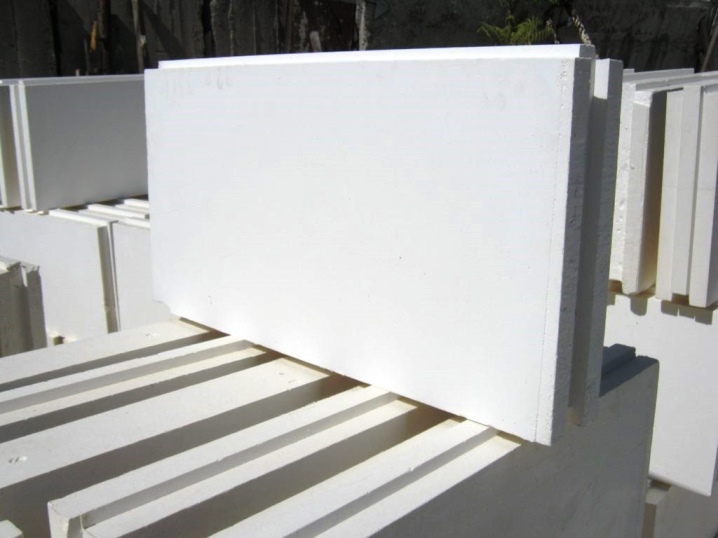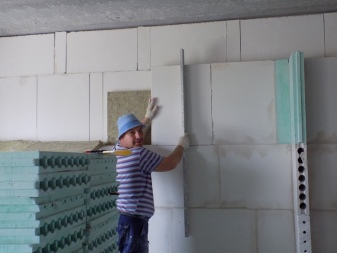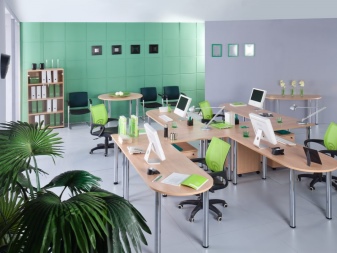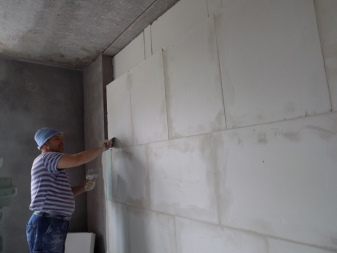Everything You Need to Know About Gypsum Tongue Slabs

The main use of gypsum boards is the arrangement of internal walls and partitions. The advantages of working with this particular material do not cause any doubts: simplicity and high performance of installation, as well as affordable cost. Nevertheless, the correct choice of tongue-and-groove blocks has its own subtleties - everything you need to know about gypsum tongue-and-groove slabs we will cover in our review.

What it is?
Tongue-and-groove plate is a structure in the form of a rectangular gypsum block. On both sides of the rectangle there are grooves, on the other two there are ridges. This is where the name GWP comes from. Advantage material lies in the fact that such blocks can be docked together without gaps and distortions. Tongue panels are very popular in the construction of interior partitions. They are optimal for residential use.
The material from which GWP is made is safe for health, it does not burn and serves for several decades.

Advantages and disadvantages
Builders love tongue-and-groove gypsum slabs for the standard of parameters, compliance with GOST, as well as the convenience of working with them. The main advantage of tongue-and-groove slabs is their affordable cost. - the prices for this material are much more attractive than for any other wall materials, such as gas silicate blocks or sand concrete. In addition, the slabs are easy and simple to assemble. by gluing, thanks to which a high speed of construction work is ensured.

Another advantage of gypsum board is absence of any wet processes. Installation of GWP does not require plastering work, since initially this material is produced with a leveled smooth surface. Thanks to this, immediately after the installation of the partitions, you can paint them or paste over with wallpaper. The use of these blocks greatly increases the productivity of work and significantly reduces the time for the construction of any objects.
Typically, a team of two finishers can make a 20–25 m² wall in just one day.

There are no drawbacks as such for the GWP. However, it should be borne in mind that after purchase, they must certainly be acclimatized indoors - before starting work, you need to withstand them when heated at least +5 degrees for 4-6 hours. In addition, load constraints should be considered. Some types of GWP cannot be used for the construction of partitions on which it is planned to mount heavy furniture blocks or other bulky structures.

Varieties and sizes
Tongue gypsum polymers are available in two versions, such as:
- ordinary panels are made of gypsum with the addition of plasticized impurities, such panels have a gray tint;
- moisture resistant slabs, in addition to gypsum, also contain cement and granulated blast furnace slag; such slabs are painted green.

Important! Standard gypsum boards are suitable for installing partitions in rooms with an average level of humidity; for bathrooms and showers, it is better to give preference to products with green markings.
Gypsum blocks can also be made hollow and solid.
- Solid slabs are characterized by a monolithic one-piece structure. They are quite strong, it is impossible to break such a partition, even if you kick it with an effort.Plates are produced in dimensions 667x500x80 mm, block weight - 32 kg.
- Hollow modules have uniform longitudinal holes throughout the entire area. Thanks to this feature, the blocks are much lighter - due to this, the load on the supporting frame of the partition is significantly reduced. Plates of the same length and width with a thickness of 80 mm already weigh 24 kg.

Hollow slabs are in demand when performing construction work, which is explained by their following undoubted advantages:
- reducing the total cost of repair and construction work by reducing transportation costs, as well as increasing the speed of installation work;
- during technical operation, hollow core slabs successfully withstand any household loads;
- the air gap increases the ability of partitions and walls made of hollow blocks to retain heat in the room; Thus, the installation of hollow core slabs assumes the most economical approach to organizing construction work and reducing overall costs.


Areas of use
Tongue partition blocks are a material that it is distinguished by exceptional environmental friendliness, safety for people and the environment. The gypsum from which these blocks are made is in itself environmentally friendly: under the influence of high temperatures, it does not emit harmful and toxic fumes, in addition, it does not have any smell. Plaster tongue-and-groove belongs to the category of non-combustible materials, that is why it can be used in rooms of any type and purpose. GWP is used in office, industrial premises, as well as in living rooms, including children's rooms. The material is in demand in the construction of hospitals and other medical institutions.


The structural features of tongue-and-groove slabs dictate their own operating standards. For example, for the installation of walls on which it is planned to fix a TV or cabinet, it is best to use full-bodied panels, since it will be rather difficult to fix fasteners in hollow ones. In all other cases, a lightweight panel can be used. For residents of private houses, it is better to use full-bodied modules for the construction of partitions, since rodents and pests can settle in hollow ones.


Selection Tips
Tongue gypsum panels in the modern construction market are represented by products several manufacturers... The most popular are the products of the companies Volma and Knauf. It is not easy to give an unequivocal answer about which manufacturer is better - each of them occupies its own niche, which is unique in many ways. That is why, for a start, you should thoroughly understand why the partition from the PGP will be erected.

So, if you need a full-bodied gypsum board, regardless of whether it is ordinary or moisture resistant, then preference should be given to products Knauf... When comparing the quality of products from both manufacturers, Knauf solid slabs are much cheaper. If you need a hollow gypsum plasterboard, then you can safely opt for tongue-and-groove products Volma, since Knauf does not have them in the assortment. A similar situation with blocks 100 mm thick - the Volgograd plant simply does not produce them.

To the benefits of Knauf also include the convenience of their transportation. The goods are sold and transported in pallets covered with plastic wrap - it protects the gypsum from moisture and other atmospheric influences, which is why the material can be transported by different types of transport and in any weather. In extreme cold, so that the boards do not freeze among themselves, packing is performed using a special interlayer between each panel.

Important! As for general recommendations, when choosing a PHB, it is extremely important to take into account the peculiarities of the operation of the partition, that is, the load on the plate, the possibility of installing a TV and furniture blocks on it.In addition, the parameters of the room are of no small importance - the level of humidity in it and the temperature regime.


Installation features
The installation of partitions from GWP is performed after the completion of the installation of any supporting or enclosing structures. Work is carried out in dry or normal humidity conditions when the air in the room is heated at least + 5 degrees. When carrying out construction work in the winter, a heating connection is required.

First you need to remove all dirt and construction dust from the base walls, as well as the surface of the ceiling and floor. After that, you need to mark the location of the future partition on the floor, and then, using a plumb line, carefully transfer this markup to the walls and ceiling, fix the areas for window and door openings. If the base is curved and has noticeable irregularities, then a leveling screed should be performed so that the horizontal surface becomes level.

Gypsum boards are laid using assembly glue, the most effective way is "GIFAS Gypsum Glue" or "GIFAS Gypsum Putty". When working with moisture-resistant compounds, hydrophobic compounds give the best adhesion. With the aim of improving the sound insulation characteristics of tongue-and-groove slabs when fixing them to the enclosing structures, you can use an elastic gasket, most often it is a cork with a density of 50 kg / m³ or bitumen felt with a density of 250-300 kg / m³, as an alternative, you can fix low-density fiberboard.


Depending on the specifics of the production, gypsum boards can be placed either with a puzzle down or with a puzzle up. Experts recommend using the puzzle upward laying, since then the glue will be better redistributed in the slab space. To do this, for all GWPs located in the first row, you need to remove the comb. The plates are fixed apart, which ensures the greatest rigidity of the structure. The slabs of the very last row should have slightly beveled edges in the area of abutment to the floor. The space between the ceiling and the slab of the last row (approximately 2-3 cm) is filled with gypsum glue throughout the entire volume.

Openings are inserted into the partitions for installing windows or doors in them. If the width of the opening is not more than 800 mm and only one row of panels is located on it, then there is no need to put the lintel beam, in this case you can put a regular door frame. If the width of the opening exceeds 800 mm, then the installation of the lintel beam is necessary, it will relieve the load from the upper rows of blocks. The embedment size is approximately 500 mm on each side. Door frames are fixed with special dowels or screws. The vertical joints of the slabs located next to the openings must be at least 20 cm apart.

In the corners, as well as in the areas of intersection of partitions with each other, GWPs should be laid in such a way that they in turn cover the joints. At the same time, it is important to try not to allow vertical joints to turn out to be through. The upper corners are additionally fixed with a perforated metal profile. Reinforcement tape is used to process the inner corners. The internal joints of partitions made of hydro-resistant PHB must additionally be covered with a waterproofing tape, it plays the role of a sealant.

Important! Any metal objects that are inside the partitions or mate with them must necessarily have a reliable anti-corrosion coating or be galvanized. If, for some reason, the gypsum polymer wall has depressions or bumps, rework is required. To do this, a leveling layer of putty is applied in the zones of the depressions, and the bumps are easily removed using a conventional roughing plane.

After the putty or glue dries, the surface of the walls is carefully sanded. The gypsum polymer partition is ready - all that remains is to complete the finishing, usually the GWP is painted with interior paint or pasted over with wallpaper.We hope our recommendations will help you make the right choice of tongue-and-groove gypsum board and perform all installation work on your own.


For everything you need to know about gypsum tongue-and-groove slabs, see the following video.













The comment was sent successfully.